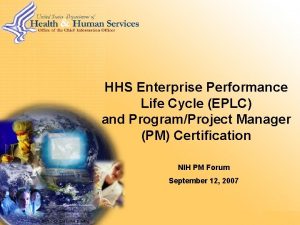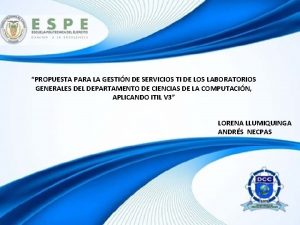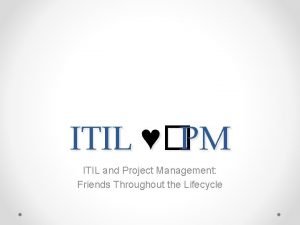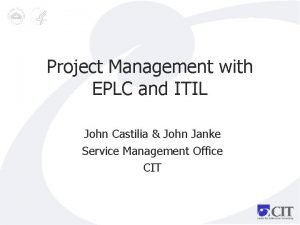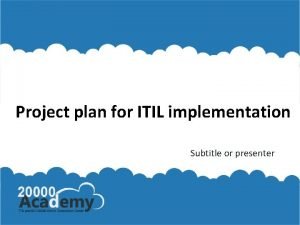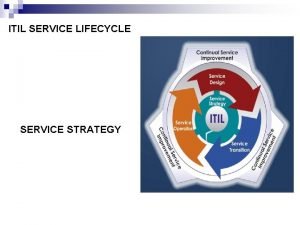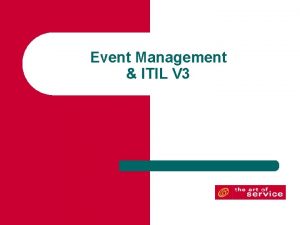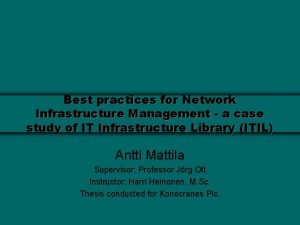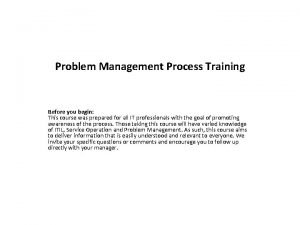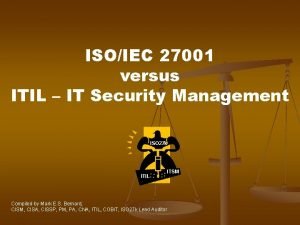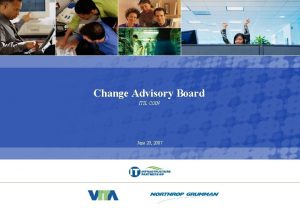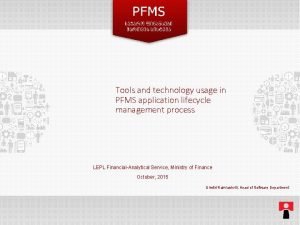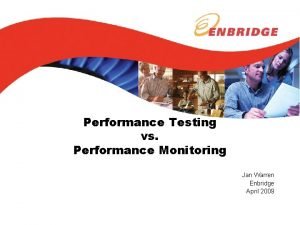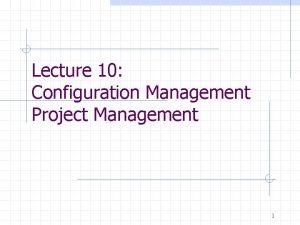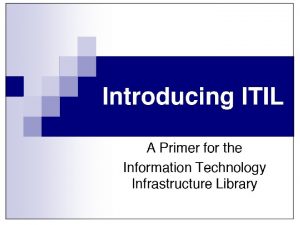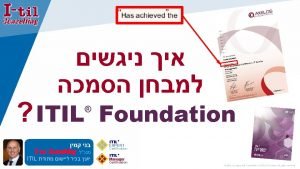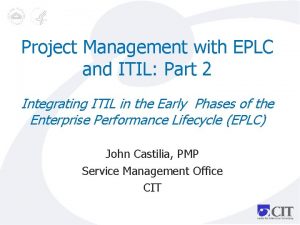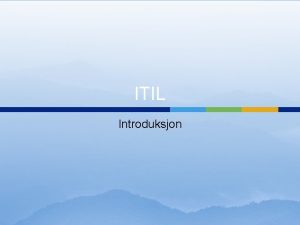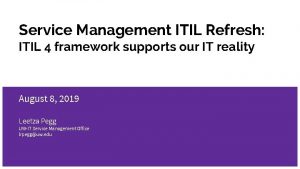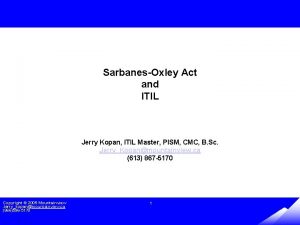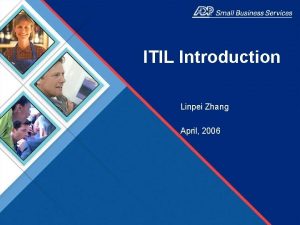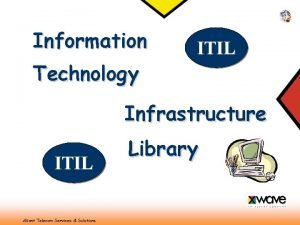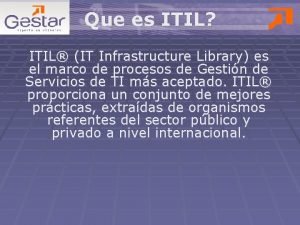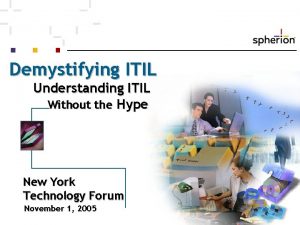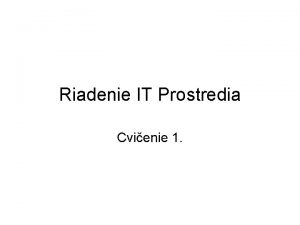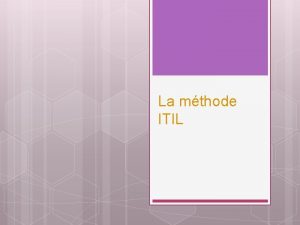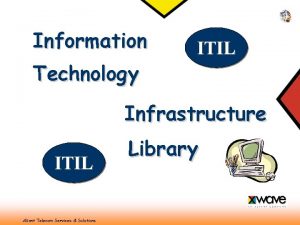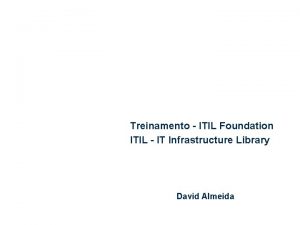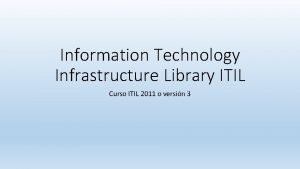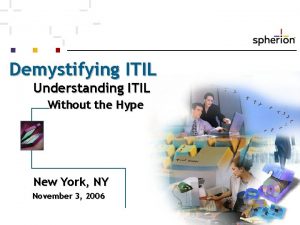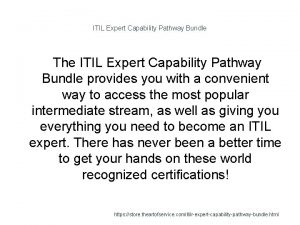Project Management with EPLC and ITIL John Castilia




























- Slides: 28

Project Management with EPLC and ITIL John Castilia & John Janke Service Management Office CIT

Presentation Goals • Provide a suggested approach for managing projects in alignment with EPLC and ITIL • Offer a brief Refresher on EPLC and ITIL • Resolve confusion about the role of EPLC and ITIL in project management • Examine why that confusion exists

The Project Management Challenge • Meet requirements and targets for: • Quality • Time • Budget • Scope • Manage project scope • Handle the numerous approaches which exist to aid in successful project completion

In the Imperfect World of Project Management • Frameworks such as PMBOK, PRINCE 2, EPLC, CPIC, and CMMI promote success – Based on industry good practice – Typically customized to meet specific constraints – May introduce additional work – Can increase time and cost, but not necessarily perceived value to the customer, project managers, and organizational management

Benefits of Frameworks • Improve consistency of performance • Increase competitive advantage • Raise effectiveness and efficiency • Enhance organizational capabilities • Lower costs and risks • Improve collaboration across projects

The Balancing Act • Incorporate the benefits of frameworks to: – improve project excellence – enhance organizational project management – comply with regulations, mandates, etc. • While simultaneously protecting against: – – expensive, procedural “overhead” non-applicable framework elements overly rigid adherence to standards erosion of value perceived by the customer

Confusion about EPLC and ITIL • EPLC and ITIL seem to: • compete with one another • have the same purpose • create similar deliverables • add little value • complicate “getting it done”

Clearing the Confusion 1. Learn enough about EPLC and ITIL in order to benefit: • • • the project management effort the customer the organization 2. Introduce a suggested EPLC/ITIL approach that complies with the rules and adds value during the life cycle

Purpose of EPLC “A key to successful IT management is a solid project management methodology that incorporates best government and commercial practices through a consistent and repeatable process, and provides a standard structure for planning, managing and overseeing IT projects over their entire life cycle. The HHS Enterprise Performance Life Cycle (EPLC) framework provides that methodology for HHS. ” Office of the CIO, Office of the Assistant Secretary for Resources and Technology, Health and Human Services, Enterprise Performance Life Cycle Framework Overview Document , (Washington, DC: January 18, 2010), 3.

Enterprise Performance Life Cycle

Purpose of ITIL “ITIL is used by organizations worldwide to establish and improve capabilities in service management. ” Office of Government Commerce (UK), ITIL: Service Strategy, (Norwich, UK: The Stationery Office, 2007), 7. “Service Management is a set of organizational capabilities for providing value to customers in the form of services. ” Office of Government Commerce (UK), ITIL: Service Strategy, (Norwich, UK: The Stationery Office, 2007), 250.


What’s Common: EPLC and ITIL ü Lifecycle-based ü Parallel (but not identical) terms ü Matching activities ü Comparable goals ü Process Driven ü Allow tailoring ü Non-prescriptive

EPLC and ITIL Differences EPLC ITIL • Is mandated • Stage Gates are governance check-ins • Is designed specifically for HHS OPDIVs • Focus on project control and accountability • Project-based • Often an organizational requirement • “Mesh” Approach – No Stage Gates • Is designed from research done in many industries around the world • Focus on value created and delivered to customer • Service-based

The Most Significant Distinctions • Mandated vs. Non-Mandated • Assume EPLC must be done • Allow for Project Management and Service Management differences • Comprehending Projects vs. Services is the fulcrum with which to leverage framework benefits • Necessary Definitions: IT System, IT Service, IT Project

What is an IT System? • An integrated composite of one or more of the processes, hardware, software, facilities, formal documentation, people, and configuration items that provides capability to satisfy a stated need or objective. • A collection of configuration items (hardware, software, and documentation) that are necessary to deliver an IT Service.

What is an IT Service? • Service – Delivers Value – Facilitates Outcomes • Enhances Performance • Reduces Constraints – Owns costs and risks – Increases the probability of desired outcomes

What is an IT Project? “A project is a temporary planned endeavor funded by an approved information technology investment; thus achieving a specific goal and creating a unique product, service, or result. A project has a defined start and end point with specific objectives that, when attained, signify completion. ” Office of the CIO, Office of the Assistant Secretary for Resources and Technology, Health and Human Services, Enterprise Performance Life Cycle Framework Overview Document , (Washington, DC: January 18, 2010), 10.

Hierarchy of Definitions Definition Example Business Value Public Health Business Service Grants Management IT Service Grants Management Service - e. RA IT System(s) Grants Management Database System – IMPAC II IT Component(s) Grants Management Hardware, Software, etc. - QVR

Project and Service Management Projects Services • Projects should be used to build services and systems • Service management does not typically develop solutions • Projects have defined deliverables • Service Management run operations • Projects end or have signifiers of completion • Services are rarely built to be handed off to another party • Transfer of “ownership” from development organization to customer organization • Services are ongoing • Assume costs and risks on behalf of customer

Management Domains Activity Business Value Business Management ITSM (ITIL) Project Management (EPLC) Roles Research Business Service Laboratory Management IT Service Facilities Access IT System(s) FACNet IT Component(s) Access Card Reader EPLC and ITIL blur when development and operations overlap Business Managers IT Leadership/ Service Owners Project Managers Technical Managers

Suggested Decision Table: Project or Service Example Transfer of Ownership Transfer of Management Signifier of Completion Type Web Site Y Y Y Project Email Server Y Y N Service* NBS Y N N Service* Service Catalog N N N Service* Laptop Battery Swap N N Y Project Share. Point Site N Y Y Project ● ● Services assume the ownership their systems ● Both the EPLC and ITIL should be tailored to satisfy requirements *Systems and other solutions developed in support of services should, therefore, be built with the EPLC

Example 1: A Database Deciding Factors Will the major deliverables be operated by the customer? Yes Does the customer assume the costs and risks? Yes Does the customer own the final product? Yes Is there an established end date or other signifier of completion? Yes This cannot be a service, should follow the EPLC, and be tailored to meet requirements

Example 2: Remote Access System Deciding Factors Will the major deliverables be owned and operated by the customer? No Does the customer assume the costs and risks? No Does the customer own the final product? No Is there an established end date or other signifier of completion? No • This is system that will support a service and better run with the ITIL framework, but the system itself should be built with the EPLC

Deliverables and Outputs Question: Doesn’t that mean two sets of deliverables? One for ITIL and one for EPLC? Answer: No! EPLC has deliverables and these can be used to satisfy ITIL outputs. • There are no mandated or required ITIL outputs. • ITIL strongly suggests that there are outputs. • EPLC is more structured as deliverables are required for Stage Gate reviews.

The Confusion Allayed? • Service Management uses Project Management to build its systems (. . . EPLC enhances ITIL) • Project Management uses Service Management to run what it builds (. . . ITIL enhances EPLC) • Guidance from one can help accomplish the other, i. e. , – Use ITIL guidance for EPLC release documentation – Could use EPLC documents as part of ITIL process.

Final Thoughts • EPLC strengthens project management rigor and accountability through a mandated process. • ITIL provides a service management framework. The ITIL processes within that framework exist for the primary purpose of planning, delivering and supporting IT services. • Together EPLC & ITIL enhance our organizational capability to deliver value to our customers.

Questions ? Service Management Office Contacts John “Jack” Castilia, PMP Project Manager John Janke, ITIL Service Manager Process Engineer
 Eplc
Eplc Https://www.servicetonic.es/itil/introduccion-a-itil-v3/
Https://www.servicetonic.es/itil/introduccion-a-itil-v3/ Project management in itil
Project management in itil Eplc definition
Eplc definition Traditional project management vs modern project management
Traditional project management vs modern project management Itil implementation project plan
Itil implementation project plan Itil lifecycle management
Itil lifecycle management Event management itil
Event management itil Infrastructure management best practices
Infrastructure management best practices Problem management expert is responsible for
Problem management expert is responsible for Isoiec27001
Isoiec27001 Itil change advisory board
Itil change advisory board Application lifecycle management itil
Application lifecycle management itil Release management itil
Release management itil The role of project management in achieving project success
The role of project management in achieving project success Process discriminants in software project management
Process discriminants in software project management Reasons for reducing project duration
Reasons for reducing project duration Introduction to project management kathy schwalbe
Introduction to project management kathy schwalbe Software project evaluation
Software project evaluation When conducting post project audits
When conducting post project audits Ms project agile
Ms project agile Types of terminations
Types of terminations Asset management vs project management
Asset management vs project management Configuration management system pmp
Configuration management system pmp Principles of project cost management
Principles of project cost management Software
Software Project integration management
Project integration management Desventajas del cobit
Desventajas del cobit Lynda itil
Lynda itil
